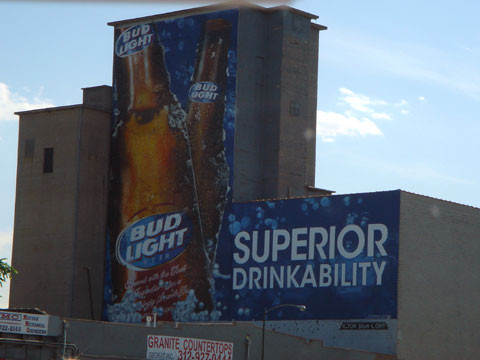Usability and Familiar Symbols
 A large part of usability is the ease for how anything – from a Web site to a coffee maker and beyond – can be, well, used. Familiarity can have a significant impact on usability. If someone used something elsewhere that looks familiar in something else, they may be able to use this new item here.
A large part of usability is the ease for how anything – from a Web site to a coffee maker and beyond – can be, well, used. Familiarity can have a significant impact on usability. If someone used something elsewhere that looks familiar in something else, they may be able to use this new item here.
I have experienced this first hand when traveling abroad. A couple of years ago my lovely wife and I visited Denmark, and this was the first time I did a fair amount of driving outside of the US. Where I did not speak the language, I was able to get around on the roads as the international driving signs and symbols were familiar to me. Even if the Danish words were not familiar, the overall symbol’s shape and color were, and as a result I knew what to do, and did not get into an accident.
This came to mind recently on a trip to the Babies R Us store in Chicago. On the front entrance is a sign that reads “Entrance Only” however the words are inside of the international symbol for “do not enter” as shown in the accompanying photo The first time I went to the store, I paused for a moment as I got a mixed signal – the sign reads enter, but the symbol says not to. As many stores employ the green enter and red do not enter signs, my reaction was not unusual. Realizing this was the only way in, I proceeded to enter. Looking back as I did, I was not the only person to proceed with caution upon approaching this door.
Where I don’t design retail stores, I design Web sites. The adherence to consistency and commonly accepted standards is vital to the success of a Web site. If a Web visitor doesn’t know they should click on something, they won’t. Hopefully this is not referring to a “buy” button on a Web page. The above-mentioned sign may not have turned someone completely away from shopping at Babies R Us, but that was probably due more to the fact they drove to the store and eventually figured they could enter. With a Web site, you may not have that luxury of someone being that persistent, and they will seek a Web site that is more familiar to them.
Did you enjoy reading this? You are welcome to subscribe to The Hot Iron by RSS feed or by email.
Lowest Common Denominator Or Strategic
While sitting in traffic on the Eisenhower Expressway in Chicago, this billboard for Bud Light was staring at me for about 5 minutes, as shown in the photo below:

The photo shows 2 icy bottles of Bud Light with the large caption, “Superior Drinkability.” As I stared back at the billboard, I questioned to myself, “doesn’t that mean simply that you can drink it?”
Being someone who has consumed a few beers in my lifetime, the fact that I could drink the beer before me never came to mind. I was more concerned with the taste. Several hours later when I got home I looked up the word drinkability at Merriam Webster’s and was given a definition of “suitable or safe for drinking.”
Suitable? Safe? Or more importantly, what is Budweiser’s intent with this message? Are they taking their product to the lowest common denominator and saying that it can be consumed, or are the being strategic and appealing to something that – as you can read above – is beyond me?
Excuse me if I am missing the point, and if you get it, I would appreciate your insight. If it were me, I would think there were more merits to my product.
Did you enjoy reading this? You are welcome to subscribe to The Hot Iron by RSS feed or by email.
Wordless Wednesday - Northern Illinois University Flag Over Wrigley Field

Did you enjoy reading this? You are welcome to subscribe to The Hot Iron by RSS feed or by email.
6 Questions with Peter “Dr. Pete” Meyers
 1 - Who are you, and what are you doing here?
1 - Who are you, and what are you doing here?
My name is Peter Meyers (AKA "Dr. Pete"), and I run a website usability consulting firm here in Chicago called User Effect (www.usereffect.com). I like to say that I'm a coder by blood and psychologist by training. I've been programming since I was 9, and I think it's just in my genetic code somehow. Ultimately, I see the computer as a tool first, and I'm also fascinated by the idea of the human mind as a tool, so I ended up double-majoring in college and went on to do my Ph.D. in cognitive psychology. Long story not-quite-as-long, the internet boomed when I was in grad. school, I went to work for a start-up in 1997, helped build it into a $1.5M web services company and then left in 2005 to start my own business and get back to what I love, helping clients understand their online customers.
2 - To the layman, what is cognitive psychology and how does it relate to the Internet?
The stock answer is that cognitive psychology is the study of human cognition, but that's not very helpful :) Essentially, it's the study of all of the pieces that make up how adults think and process information, including learning, memory, and perception. It's very relevant to human-computer interaction and understanding the ways people react and respond to information online, including, of course, commercial websites.
3 - Can you site an example of applying your education and background to improve a Web site or online experience?
One of the major areas where my experience converges is in website testing, which is essentially creating a mini-experiment online. The simplest example is A/B or split testing, where we put out 2 versions of a web page to 2 groups of users and measure which one performs better. This is definitely an area where my training as a research scientist comes in handy, both in figuring out what to test and how to interpret the results. Of course, experience comes in handy, but the results often surprise me, which is part of the fun.
4 - Have Internet users become "smarter" over the years, or is it hard to even measure that with the growing population as well as aging of users?
"Smarter" is a really loaded word that I'm going to try to tap-dance around. It is amazing how quickly people have gotten used to the internet and have developed certain habits, such as recognizing underlined, blue links, or exhibiting the so-called "F-shaped" eye movement pattern (showing preference for the top and left first). Whether the internet is making us smarter or dumber is open to debate, but we're definitely learning to adapt to it as a tool and are, in my opinion, using it more effectively and creatively.
That said, your "average" user is probably 2-3 years behind the usage patterns of we techie types. A lot of e-businesses still overestimate what visitors want, in terms of cutting-edge features and functions, and would be better off sticking to the basics.
5 - Five years from now, do you think we will be talking about usability and user-centricity on the Internet as a separate discipline, or will it be more ingrained in Web design and development?
This discussion pops up a lot in usability and user experience (UX) circles. As much as we take the internet for granted, it's still really in its infancy, and I think it's only natural that the areas of expertise are going to diverge over time. I tend to see myself as a bit of a generalist, but we're definitely going to see fields such as design, usability, online marketing, search engine optimization, etc. split into specialties. I do think that user-oriented design is already a bit of a specialty, and hopefully one we're going to see more of.
6 - What is one question I did not ask, and what is its answer?
I hate to sound cliche, but I'm really interested by the question of where the internet is headed in the next 5/10/20 years. I'm not sure I can answer "Where will the internet be in 5 years?", but I think we've taken the web for granted so quickly that we don't realize that: (1) it's already revolutionized our lives, and (2) this is just the tip of the iceberg. I think that we're going to tap the so-called wisdom of crowds more effectively as time goes by, and the internet will become a vehicle for not just generating content, but new ideas, products, and even social constructs. As it does, psychology and sociology are only going to come into play more and more.
Did you enjoy reading this? You are welcome to subscribe to The Hot Iron by RSS feed or by email.
MillerCoors Should Make No Little Plans In Chicago
 It was announced on Tuesday that MillerCoors, a new joint venture of beer makers SAB Miller and Molson Coors, would setup their headquarters in Chicago. This will move employees from Denver and Milwaukee to the Windy City and in total bring in close to 400 jobs. The exact location of the office, to be opened within a year, has not been determined.
It was announced on Tuesday that MillerCoors, a new joint venture of beer makers SAB Miller and Molson Coors, would setup their headquarters in Chicago. This will move employees from Denver and Milwaukee to the Windy City and in total bring in close to 400 jobs. The exact location of the office, to be opened within a year, has not been determined.
As the corporate executives make their plans to move to Chicago, I have one suggestion – make no little plans! These words are not my own but of Daniel Burnham, the world renowned urban planner responsible for the layout of much of what is Chicago today. I thought of this after my visit to the Tribune Tower last week, which is not only the headquarters of the Chicago media empire but a museum and tribute to journalism.
Most corporate offices are just that – offices. Why not make it a showcase of your products and services? Unfortunately, many of the corporate giants in Chicago haven’t incorporated this into their business model. Wrigley does not have a candy and gum store. Boeing has a store to buy logo schwag but no exhibits on its airplanes. Morton Salt could have an umbrella store. United Airlines, well… maybe they are a bad example as they don’t like their customers to begin with.
The only examples I could think of in Chicago are the Chicago Board of Trade’s viewing gallery, the Vienna Beef headquarters which has a cafe and store featuring its tasty foods, and the former Marshall Field’s which used to have a history gallery before they were acquired by Macy’s.
Such showcases don’t have to be merely cost centers – they can be profit centers, making money from visitors. MillerCoors could have a history museum, a working mini-brewery, an R&D facility open to the public and a restaurant. They could even borrow from Jordan’s Furniture in the Boston area which has everything from an IMAX theatre to motion-odyssey ride in its furniture stores. Anything else come to mind?
As much as another corporate headquarters in itself can have a positive impact on any community, making a big splash by offering something more and different to that very community can go a long way. Corporations don’t just have to write checks to participate. They can make their own things happen.
Did you enjoy reading this? You are welcome to subscribe to The Hot Iron by RSS feed or by email.
Page 148 of 217 pages ‹ First < 146 147 148 149 150 > Last ›


